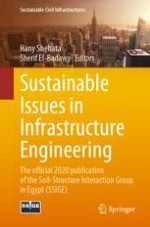2021 | Book
Sustainable Issues in Infrastructure Engineering
The official 2020 publication of the Soil-Structure Interaction Group in Egypt (SSIGE)
Editors: Dr. Hany Shehata, Prof. Dr. Sherif El-Badawy
Publisher: Springer International Publishing
Book Series : Sustainable Civil Infrastructures
